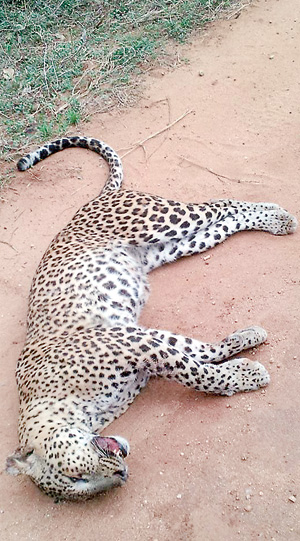News
Perhaps this leopard did not die in vain
View(s):When the Sunday Times broke the story about the leopard killed in a hit-and-run accident inside Yala National Park last Friday the issue went viral on social media, reaching a peak when Prime Minister Ranil Wickremesinghe stood up for action.
In a post on his official Facebook page the Prime Minister said his government was looking into how it could implement strict enforcement of speed limits and further restrictions on the rate of visitors “to each of our national parks and reserves, in order to create an environment that is safe and secure for all its inhabitants”.
 Environmentalists welcomed the statement, hoping that at last there would be action to control the safari madness at the country’s most popular national park, which attracted gets nearly half a million tourists last year. The issue of over-visitation is linked to bad planning of the tourism industry, some experts point out. A number of new hotels has been built in the area, resulting more visitors to Yala. So the tourism industry itself needs to come forward to plan sustainable use of the park, not allowing the industry itself to kill the goose that lays the golden egg.
Environmentalists welcomed the statement, hoping that at last there would be action to control the safari madness at the country’s most popular national park, which attracted gets nearly half a million tourists last year. The issue of over-visitation is linked to bad planning of the tourism industry, some experts point out. A number of new hotels has been built in the area, resulting more visitors to Yala. So the tourism industry itself needs to come forward to plan sustainable use of the park, not allowing the industry itself to kill the goose that lays the golden egg.
There are other national parks in the country, some of them scenic beauties but very much under-developed and recording very low visitation. These should be developed and promoted as an attempt to divert visitors to other biodiversity in the country.
This is not the first time an animal has been killed in Yala. In 2011, a young leopard was knocked inside the national park while in 2012, another jungle cat was killed.
Environmentalists are happy that the country’s prime minister has now announced that, “As an animal lover myself, this matter is very close to my heart”, and they hope the words are sincere. -M.R.
Please make it one portfolio, say activists
Gamini Jayawickrema Perera was given the Wildlife portfolio when the new ministry was announced on Friday and it is assumed that President Maithripala Sirisena will continue as the Minister of Environment. This has disappointed environmentalists who hoped that all agencies relating to the environment be placed under one ministry to allow for better coordination.
At a press conference convened by the Environmental Collective on Wednesday, environmentalists pointed out the importance of having all the related Environment agencies under one roof. The main concern is that the Department of Wildlife Conservation (DWC) and the Forest Department (FD) are assigned to two different ministries.
The Coast Conservation and Coastal Resource Management Department, Central Environment Authority, Geological Survey and Mines Bureau, Marine Environmental Protection Authority, Gem and Jewellery Authority and the Wildlife Trust are the other state departments and agencies that environmentalists desire to be brought under one ministry.
While saying that the guardianship of wild animals of Sri Lanka is considered to be primarily under the DWC but there are wild animals in the forests belonging to Forest Department, Pubudu Weeraratne of the Species Conservation Centre gave an example with humour to explain the ineffectiveness before of lack of coordination between agencies.
“There are instances where electric fences with the aim to solve human-elephant conflict are being built to demarcate protected areas belonging to DWC but on the other side it becomes a forest under the Forest Department – and there are elephants on both sides of the fence,” Mr. Weeraratne said.
“A minister from an urban electorate such as Colombo would be better as the Minister of Wildlife,” said activist Nayanayaka Ranwella, pointing out that provincial politicians were bound to favour their supporters, who are often behind wildlife crimes.
He said environmentalists were truly happy that President Maithripala Sirisena had himself come forward to keep the portfolio, indicating that for the first time the environment is an important subject.

